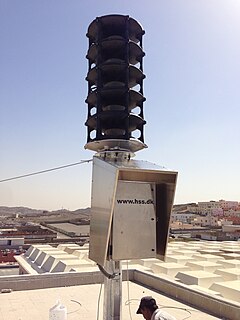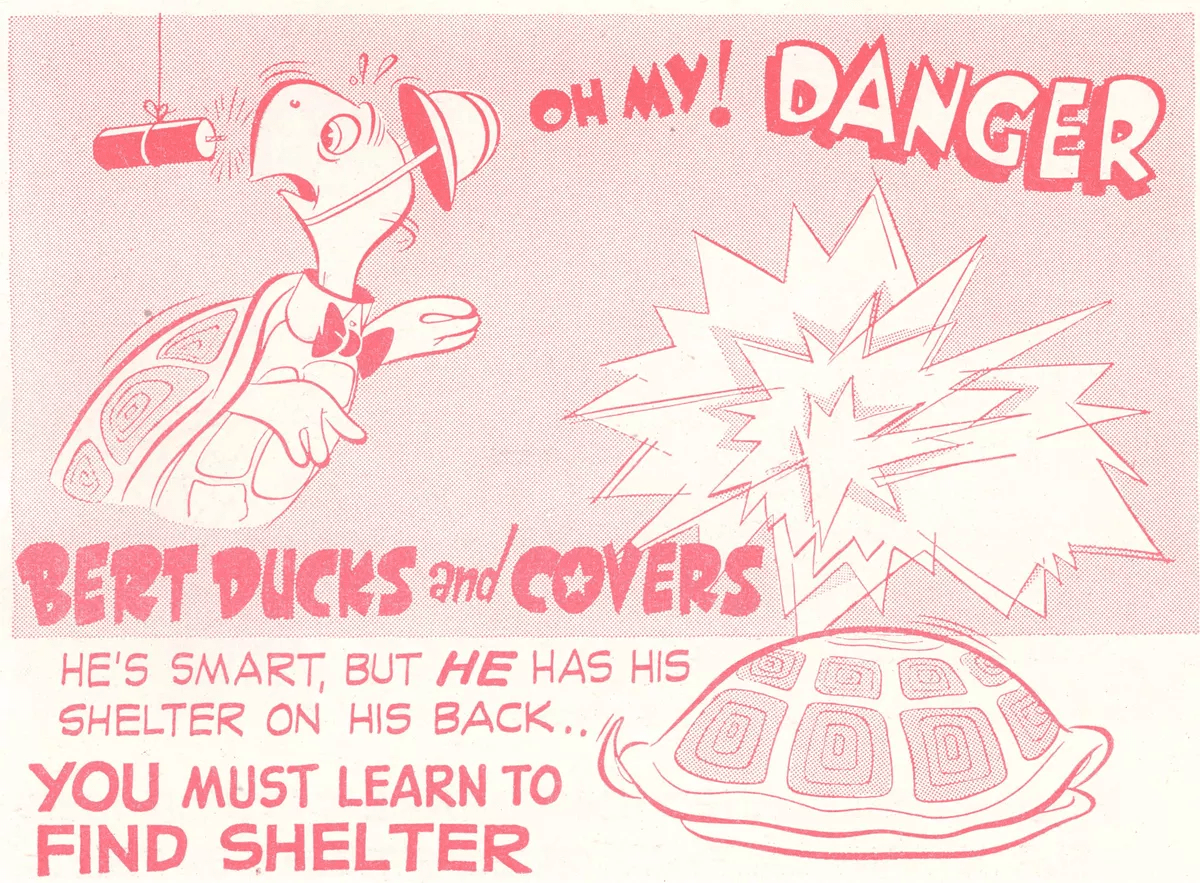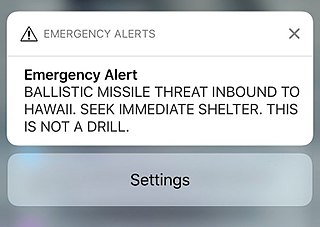
Civil defence or civil protection is an effort to protect the citizens of a state from military attacks and natural disasters. It uses the principles of emergency operations: prevention, mitigation, preparation, response, or emergency evacuation and recovery. Programs of this sort were initially discussed at least as early as the 1920s and were implemented in some countries during the 1930s as the threat of war and aerial bombardment grew. It became widespread after the threat of nuclear weapons was realized.

A fallout shelter is an enclosed space specially designed to protect occupants from radioactive debris or fallout resulting from a nuclear explosion. Many such shelters were constructed as civil defense measures during the Cold War.

A civil defense siren is a siren used to provide an emergency population warning to the general population of approaching danger. It is sometimes sounded again to indicate the danger has passed. Some sirens are also used to call the volunteer fire department when needed. Initially designed to warn city dwellers of air raids in World War II, they were later used to warn of nuclear attack and natural destructive weather patterns such as tornadoes. The generalized nature of the siren led to many of them being replaced with more specific warnings, such as the broadcast based Emergency Alert System and the Cell Broadcast based Wireless Emergency Alerts and EU-Alert mobile technologies.

Testament is a 1983 drama film based on a three-page story titled, "The Last Testament" by Carol Amen (1934-1987), directed by Lynne Littman and written by John Sacret Young. The film tells the story of how one small suburban town near the San Francisco Bay Area slowly falls apart after a nuclear war destroys outside civilization.

"Duck and cover" is a method of personal protection against the effects of a nuclear explosion. Ducking and covering is useful at conferring a degree of protection to personnel situated outside the radius of the nuclear fireball but still within sufficient range of the nuclear explosion that standing upright and uncovered is likely to cause serious injury or death. In the most literal interpretation, the focus of the maneuver is primarily on protective actions one can take during the first few crucial seconds-to-minutes after the event, while the film by the same name and a full encompassing of the advice, also caters to providing protection up to weeks after the event.

Duck and Cover is a civil defense social guidance film that is often popularly mischaracterized as propaganda. With similar themes to the more adult oriented civil defense training films, the film was widely distributed to United States schoolchildren in the 1950s. It instructionally teaches students on what to do in the event of a nuclear explosion.
The four-minute warning was a public alert system conceived by the British Government during the Cold War and operated between 1953 and 1992. The name derived from the approximate length of time from the point at which a Soviet nuclear missile attack against the United Kingdom could be confirmed and the impact of those missiles on their targets. The population was to be notified by means of air raid sirens, television and radio, and urged to seek cover immediately. In practice, the warning would have been more likely three minutes or less.

A blast shelter is a place where people can go to protect themselves from blasts and explosions, like those from bombs, or in hazardous worksites, such as on oil and gas refineries or petrochemical facilities. It differs from a fallout shelter, in that its main purpose is to protect from shock waves and overpressure instead of from radioactive precipitation, as a fallout shelter does. It is also possible for a shelter to protect from both blasts and fallout.
A lockdown is an emergency protocol that usually prevents people or information from leaving an area. The protocol can usually only be initiated by someone in a position of authority. Lockdowns can also be used to protect people inside a facility or, for example, a computing system, from a threat or other external event. Of buildings, a drill lockdown usually means that doors leading outside are locked such that no person may enter or exit. A full lockdown usually means that people must stay where they are and may not enter or exit a building or rooms within said building. If people are in a hallway, they should go to the nearest safe, enclosed room.

United States civil defense refers to the use of civil defense in the history of the United States, which is the organized non-military effort to prepare Americans for military attack. Late in the 20th century, the term and practice of civil defense fell into disuse. Emergency management and homeland security replaced them.
Civil Defence Information Bulletin were a series of seven public information films dealing with civil defence measures individuals and families could take in the event of a nuclear attack on Great Britain. They were produced for the Home Office and the Scottish Home and Health Department by RHR Productions United Kingdom in 1964. The writer was Nicolas Alwyn and the producer Ronald H. Riley. The films are in black and white.

On the morning of Saturday, January 13, 2018, a ballistic missile alert was issued via the Emergency Alert System and Commercial Mobile Alert System over television, radio, and cellphones in the state of Hawaii. The alert stated that there was an incoming ballistic missile threat to Hawaii, advised residents to seek shelter, and concluded: "This is not a drill". The message was sent at 8:07 a.m. local time. However, no civil defense outdoor warning sirens were authorized or sounded by the state.

The first case of the global pandemic of coronavirus disease 2019 (COVID-19) in New Zealand was reported on 28 February 2020. The country has a total of 1,039 cases as of 4 April 2020. One person has died from the virus. Cases have occurred in all 20 district health board areas of the country.

The 2020 coronavirus pandemic in California is part of the ongoing worldwide pandemic of coronavirus disease 2019 (COVID-19). The first case of COVID-19 in the U.S. state of California was confirmed on January 26. A state of emergency has been in place in the state since March 4. A mandatory statewide stay-at-home order was issued on March 19. As of April 4, 2020, the CDPH says that there have been 12,026 confirmed cases and 276 deaths in the state.

The 2019–20 coronavirus pandemic spread to many countries around the world, with the most affected countries being the United States, Italy, Spain, China, France, Iran, Switzerland and South Korea. National response measures have been varied, and have included containment measures such as lockdowns, quarantines, and curfews. This is a dynamic list of different responses by various nations across the world.

The 2019–20 coronavirus pandemic reached the U.S. state of Texas in January 2020.

The 2019–20 coronavirus pandemic was first detected in the U.S. state of Georgia on March 2, 2020; the state's first death came ten days later on March 12. Governor Brian Kemp on March 23 banned gatherings of over 10 people, ordered bars and nightclubs to close, and issued a shelter-in-place order for the "medically fragile". Kemp previously declared an "unprecedented" public health emergency on March 14 and ordered on March 16 that all public schools, colleges, and universities in the state close from March 18 through the start of April. COVID-19 was first detected in a prison inmate on March 20. On April 2, Governor Kemp issued a statewide shelter in place order.

State, territorial, tribal, and local governments have responded to the 2020 coronavirus pandemic in the United States with various declarations of emergency, closure of schools and public meeting places, and other restrictions intended to slow the progression of the virus.
A stay-at-home order or a movement control order is an order from an authority to restrict movements of population as a mass quarantine strategy for suppressing or mitigating an epidemic or pandemic by ordering residents to stay home except for essential tasks or going to work in essential businesses. In many cases, outdoor activities are allowed. Nonessential businesses are either closed or changed to be working from home. In some regions, it has been implemented as a round-the-clock curfew or called a shelter-in-place order, but it is not to be confused with a shelter in place situation. Similar measures have been used around the world, but the term lockdown is used instead. Some officials have a concern that the word lockdown may send a wrong message for people to incorrectly think that it includes door-to-door searching for infected people to be forced into quarantines similar to the Wuhan lockdown.

This list of COVID-19 related curfews and lockdowns shows curfews and similar restrictions to prevent further infection with severe acute respiratory syndrome coronavirus 2 (SARS-CoV-2), which causes coronavirus disease 2019 (COVID-19), worldwide :
















